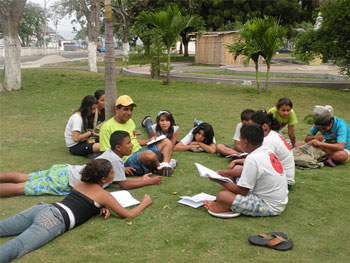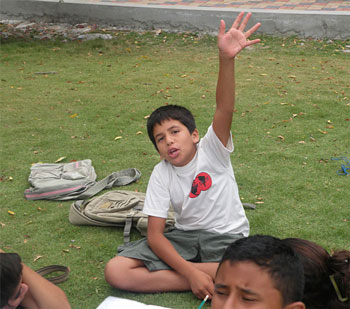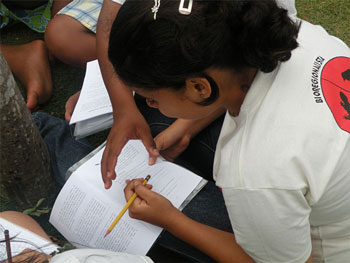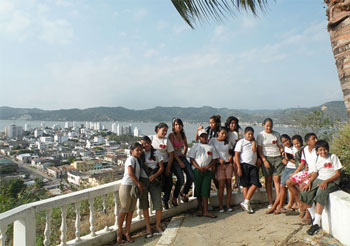Ramon’s Report #2
Bioregionalism Education
Summer Session, 2009
May 27 & 29, 2009 – English
(Click here for Spanish/Español)
Photos below

We started class at our usual time of 3:30. On this day, our main objective was to understand the steps we must take to protect our bioregion.

The kids were divided into three groups to review and analyze the main topics. Each group had to choose one person to present to the rest of the class and the kids played rock-paper-scissors to decide who.
Evelyn presented first; she told the class a little about why it is important to consume healthy food, commenting that most of us don’t know how our food is produced. She said that we all consume products that are generated in factories, and as a consequence more trash is produced and energy consumed. I asked her if she has ever consumed organic food or knows of a place where they sell it. She said that at the market they sell organic lettuce brought in from the Sierras. She also talked to us about why it is important to drink purified water for good health. She mentioned that the drinking water that we buy in jugs is extracted from the local wells and that in the winter season we obtain pure drinking water from accumulated rain water.

Giselle presented for the second group; she spoke about how it is important that we conserve and recycle the water that we use in our homes. She explained that the water we use for washing our dishes and our clothes, we can then use to water the plants. She also pointed out the large amount of electricity we waste in our houses, because we tend to leave lights or television sets on and these appliances consume energy.

Ivana commented that, like it says in our book, we should respect nature.

She said that we can start by making it a habit not to throw trash on the streets. She also told us that in her home she had a lot of ornamental as well as fruit-bearing trees, like plantains and lemons. Raul told us that in his grandma’s yard they grow papayas and “badeas.”
On Friday, we headed to the large Cross that overlooks Bahia with the purpose of evaluating how much the kids had learned this week.

On our way there, the kids observed a large amount of trash and they asked me why the city is cleaner, while the neighborhoods on the hillsides are covered with trash. I told them that the people who live in these places do not deposit their trash in the designated areas to be collected. Since there are many empty lots on the hillsides, they find it easier to dispose of their garbage there. We surmised that those individuals don’t realize that they are creating localized sites of contamination, and that the behavior is due to the lack of waste management education.

When we arrived at the top of the Cross, I asked them what makes up a bioregion. The class responded that it is made up of everything that we were seeing below us: the estuary of Rio Chone meeting with the sea, the plants and animals, the landscape, the climate and the soil. I asked them what we can do to protect our bioregion: not contaminate it, they replied. Our students from San Vicente suggested that they could take “triciclos” (tricycle taxis) instead of the motorcycle taxis.

Afterwards, we headed towards the water tanks which are located a little further up on the same hillside. Once we were there, I explained how the tanks are the source of our drinking water, which is distributed from there to the people of Bahia. We were also able to spot the water tanks across the way in San Vicente. We observed the work in progress of the bridge that’s being constructed between Bahia and San Vicente to get traffic across the estuary. I explained that it will probably produce more contamination as more vehicles come our way. On our walk down, I showed them the hillside where Planet Drum had planted trees a few years ago.
– Ramon
Translated by Paola Divita
Ramon-May 27 & 29, 2009 – Spanish/Español
Iniciamos la clase a las 3:30 como siempre. Este día de trabajo nuestro objetivo principal era tener claro cuáles son los pasos para proteger nuestra bioregión. Hicimos tres grupos y repartimos los temas para su respectivo análisis. Cada grupo tenía que elegir quien sería el expositor del tema analizado. Para esto jugaron piedra, papel o tijera; y el que quedaba de último era el expositor.
En el primer grupo participó Evelyn. Ella nos dijo que es importante consumir alimentos sanos; que por lo general no sabemos cómo se producen los alimentos ni que productos fueron utilizados para su elaboración. Le pregunté si ha consumido alimentos orgánicos o si conoce un lugar donde los venden. Me contestó que en el mercado venden en fundas plásticas lechuga orgánica, que la traen de la sierra. También nos habló sobre como es muy importante consumir agua purificada para una buena salud. Ella toma agua de bidón, ya que esta agua es extraída de pozos; también se obtiene agua pura en la época de invierno, por los desechos de la lluvia. Dijó que es verdad que todos consumimos productos que son generados en fabricas y que todos estos generan basura y consumo de energía.
Giselle, la expositora del Grupo 2, habló sobre cómo debemos aprovechar de las aguas residuales que son generadas en nuestras casas. El agua que tiramos, como la de la lavar los platos y ropa, debemos utilizarla para regar las plantas. También dijo que gastamos mucha energía eléctrica, ya que a veces en nuestras casas dejamos encendidos los focos o la tele y otros artefactos eléctricos. Y todos estos consumen energía.
Ivana comentó que, como dice el libro, tenemos que respetar la naturaleza. Al no arrojar nada que puede contaminarla, podemos crear en nosotros buenos hábitos. También habló que ella en su casa tiene muchas plantas ornamentales y alimenticias como el plátano y el limón. Raúl dijo que en el patio de su abuela tienen papayas y badeas.
El día viernes nos dirigimos al mirador de la Cruz con el propósito de evaluar a los chicos. En nuestro recorrido ellos observaron una gran cantidad de basura y me preguntaron que porque hay la diferencia de que la ciudad está limpia mientras en los barrios y las colinas hay mucha basura. Les dije que las personas que habitan en estos lugares no depositan la basura en el lugar respectivo ni la sacan cuando pasa el recolector, y como hay terrenos baldíos se les hace más fácil tirarla ahí. Racionalizamos que lo que pasa es que aquellos individuos no se dan cuenta que están creando un foco de contaminación, y que todo esto pasa por la falta de educación o orientación sobre el manejo de estos desechos.
Cuando llegamos a la Cruz les hice la pregunta: ¿Qué es una bioregión y como está constituida? Todos respondieron que es todo lo que estábamos observando y que está constituida por la cuenca del Rio Chone, las plantas y animales, los paisajes, el clima y el suelo. Yo les pregunte como es que debemos de proteger de nuestra bioregión. Ellos respondieron que no contaminándola, y no utilizando moto taxis dijeron las chicas de San Vicente. Después de esto nos dirigimos a los tanques de agua, y estando ahí les dije que toda el agua potable que viene desde la Estancia es almacenada ahí, luego distribuida a todos los habitantes. También desde ahí se podía ver el tanque de reserva de agua que está en San Vicente. Miramos la construcción del puente y les dije que eso va a originar mas contaminación, ya que el tráfico de los vehículos va a ser grande. Cuando bajamos les enseñe los árboles que ha sembrado la Fundación de Planet Drum en las laderas de las colinas.
-Ramon

Thank you for your sharing. I am worried that I lack creative ideas. It is your article that makes me full of hope. Thank you. But, I have a question, can you help me?
Your point of view caught my eye and was very interesting. Thanks. I have a question for you.
Thank you for your sharing. I am worried that I lack creative ideas. It is your article that makes me full of hope. Thank you. But, I have a question, can you help me? https://www.binance.com/es/register?ref=T7KCZASX
Your article helped me a lot, is there any more related content? Thanks!